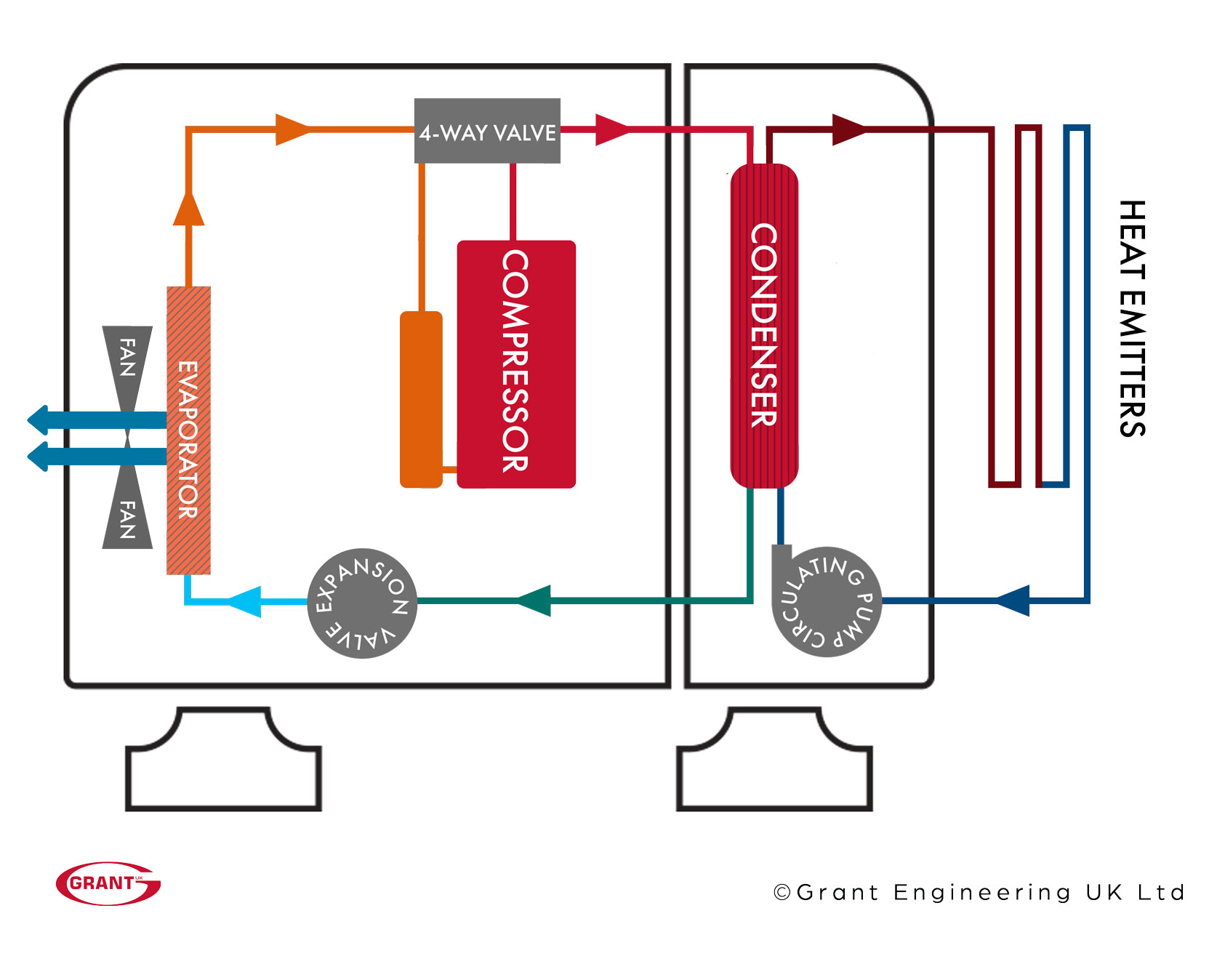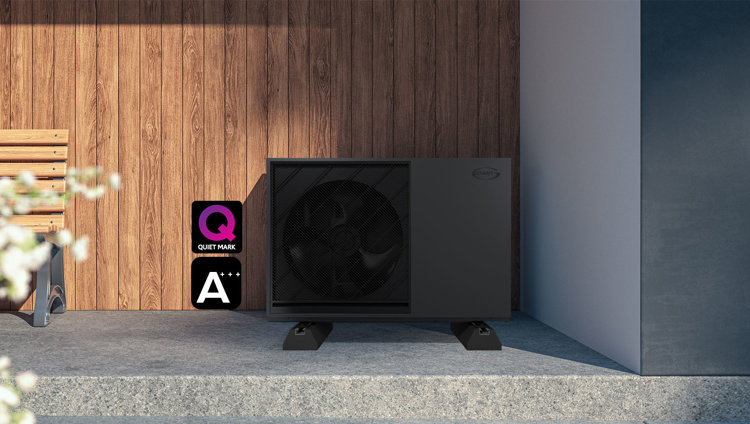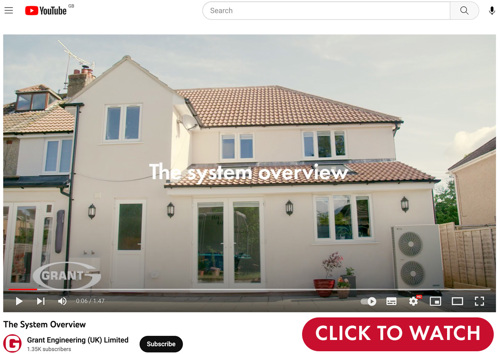Air source heat pumps are a sustainable alternative to traditional fossil fuel heating. With their green credentials and high efficiency operation, they are playing a major role in helping the country achieve its net zero carbon emission targets.
Heat pumps work differently to other types of heating systems in that they use the warmth in the air outside of your property to supply your home with the heating and hot water it needs. When correctly designed and installed, and in a well-insulated house, an air source heat pump system can be more environmentally friendly than a gas boiler. Here, we will explain how air source heat pumps work, the different types of heat pumps available, the advantages and disadvantages of heat pumps, and the considerations you should make before buying one.
How do air source heat pumps work?
In brief, air source heat pumps utilise the heat energy in the air and convert it into useable energy to heat homes. Grant’s Aerona³ heat pumps and Aerona 290 heat pumps are monobloc units and they use a vapour compression cycle which is the same as that used to extract heat from a domestic fridge.
The heat pump draws air in and transfers it over an evaporator where either R32 or R290 refrigerant is exposed to this air. The liquid refrigerant, which has a low boiling point, boils off to a gas and absorbs the latent heat energy within the air. The gas is then compressed which increases the heat content in the refrigerant before passing through a heat exchanger. Here, the gas condenses back to a liquid while transferring the heat to the water of the heating system. The liquid refrigerant is then re-circulated through the evaporator and the cycle is repeated.
The system water which has been heated up then exits the rear of the heat pump via flow and return pipework and is circulated throughout the rest of the central heating to provide space heating and hot water within the home.
To learn more about what living with a heat pump is like, please visit our YouTube channel. You can also read our blog ‘Getting Your Home Heat Pump Ready’ to find out how your property’s insulation can impact the performance of an air source heat pump.


Types of air source heat pumps
Now that we have explained how air source heat pumps work, it is also worth knowing about the different types of heat pumps available. There are two types of air source heat pumps - air-to-air heat pumps and air-to-water heat pumps. Air-to-air heat pumps take heat from the outdoor air and transfer this heat into the air within a home via fan coil units located in each room. It is important to note that these types of heat pumps do not heat water. Meanwhile, air-to-water heat pumps can fulfil both the space heating and hot water requirements for a home.
Air-to-Water heat pumps
An air-to-water heat pump takes heat from air outside and transfers this into water. Grant heat pumps are 'air to water' systems and they capture heat energy from the air outside and transfer this into 'wet' heating systems such as radiators or underfloor heating. These heat pumps also heat water stored in a cylinder which then supplies hot water to the home as well. This type of heat pump can be installed in a number of different properties - for instance, Grant’s air-to-water heat pumps have been installed in farmhouses, barn conversions, new builds and other types of domestic buildings.
Visit our case study page to see the types of properties our air-to-water heat pumps have been installed in.
Hybrid heat pumps
Hybrid heat pump systems use a heat pump alongside another heat source. These advanced hybrid systems allow homes currently using conventional fossil fuels, such as gas or oil, to incorporate more environmentally friendly and sustainable technologies like air source heat pumps into their heating solutions. These systems primarily utilise renewable energy for heating but also incorporate a traditional fuel source as a backup. Learn more about hybrid heating systems by viewing our blog ‘What is hybrid heating?’.
Monobloc Units and Split Units
Heat pumps can either be monobloc or split units. A monobloc air source heat pump is supplied as a single outdoor unit, factory assembled with no onsite refrigerant filling required. Meanwhile, split system heat pumps are supplied as two separate parts (outdoor fan unit and indoor hydro unit) and must be connected onsite with suitable pipework and filled with refrigerant by a F-gas qualified installer. Grant's air source heat pumps are monobloc heat pumps.
Air Source Heat Pump Outputs
If you are looking for a heat pump, it is essential that you do your research about the output and size of air source heat pump that will suit your home. The correct sizing of a heat pump and the correct specification of the wider system is incredibly important because an incorrectly designed heat pump system will either not meet your heating requirements or it will perform inefficiently. Grant UK supply a range of air source heat pumps that differ in outputs and sizes. Whether you are looking for a compact 4kW heat pump or the larger output of a 17kW air source heat pump, we have the solution. Take a look at our blog ‘How to Choose the Right Air Source Heat Pump’ to find out more information.
Advantages and disadvantages of air source heat pumps
Before installing an air source heat pump, you should be aware of the pros and cons of this low carbon system so that you can make an informed choice about whether it is right for you.
Benefits of air source heat pumps:
- Help reduce your carbon footprint
- Very efficient systems
- Low noise levels when operating
- Eligible for Government grants
- Can be installed alongside other renewable systems
Disadvantages of air source heat pumps:
- Initial purchase price can sometimes be higher than traditional boilers
- Space and access requirements
- Good home insulation is recommended
Learn more about air source heat pump benefits here.

Considerations before buying a heat pump
There are a few things to consider before installing a heat pump, such as your property's existing insulation levels and heat loss, installation costs and system design. To read more about these considerations and other questions to ask before buying a heat pump, please follow the link.
Air source heat pump frequently asked questions
View some of common air source heat pump FAQs below.
Can heat pumps be integrated with other renewables?
Yes, heat pumps can either be installed on their own (alongside a suitable hot water cylinder) or they can be installed alongside other renewable technologies such as a solar thermal system. By combining technologies, you can maximise your carbon savings while also reducing your energy bills. Read our blog to discover more about combining heating technologies.
How much do air source heat pumps cost to install?
Each home is different so the installation costs for installing a heat pump will vary but to view the estimated costs of a heat pump installation as well as potential savings a heat pump can make, please visit the Energy Savings Trust website. Government funding is available to help people switch from fossil fuel boilers to more sustainable alternatives and you can read more about the financial support available for heat pumps here.
How loud is an air source heat pump?
Air source heat pumps operate at low noise levels and the Grant Aerona heat pumps are no exception. In fact, all of the models in the Aerona 290 range have been awarded the Quiet Mark - you can read more about our range of R290 heat pumps here. View our video here to discover just how quiet a Grant air source heat pump is.
Find the right air source heat pump with Grant UK
You can view our range of air source heat pumps and speak to a local heat pump installer for support with researching and changing to an air source heat pump. Your installer should carry out an in-depth assessment of your home, reviewing your heating requirements and completing a heat loss calculation of your property.
Your heat pump system will need to be correctly designed and Grant UK's in-house Design and Specification Team can help you and your installer with specifying the appropriate heat pump and heat emitters for your home. Contact our team for more information on air source heat pumps.


